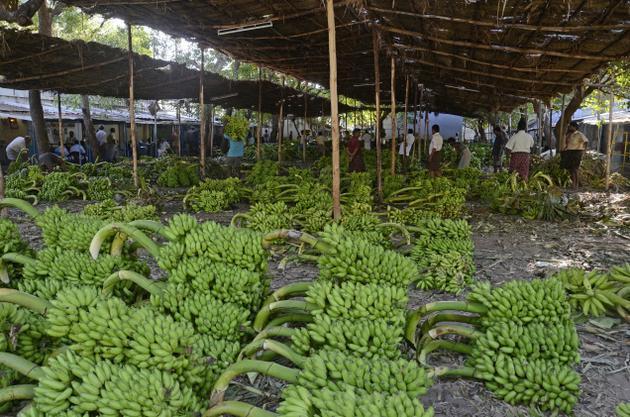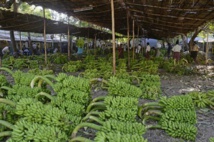The business survived the death of the top-offering Gros Michel banana in the 1950s by changing to an alternate assortment, called the Cavendish. Be that as it may, this time, there's no prepared substitute. Americans now eat bananas as much as fruits and oranges joined, and are the greatest purchasers in a fare business sector esteemed at more than $7 billion.
Some piece of the issue is the way the business developed over a century prior, depending on a solitary breed as opposed to a few mixtures. In 1870, the author of what got to be Chiquita Brands International Inc. imported 160 groups of bananas from Jamaica to the U.S. that he sold at a benefit, commencing an American industry fabricated around perishable tropical organic product from abroad that rivals modest, generally developed pieces of fruit.
Expanded Risk
While there are more than 1,000 types of bananas, numerous are devoured where they are developed or are unpalatable. To profit on fares, cultivators needed to depend on a solitary assortment to guarantee consistency and keep creation expenses low. Until the 1960s, that was the Gros Michel, which everything except vanished following a decades-in length spread of what came to be known as Panama malady.
An absence of plant differing qualities isn't one of a kind to bananas. After a history in which more than 7,000 species were developed for human utilization, today only four yields - rice, wheat, corn and potatoes - are in charge of more than 60 percent of human vitality allow, the UN's Food & Agriculture Organization gauges.
Less Tasty
Losing breeds can be unreasonable. At the point when Gros Michel was murdered off, the Cavendish demonstrated invulnerable to the parasite strain, however the bananas were littler, less strong and not as heavenly, Koeppel said by telephone from Los Angeles. It permitted the business to recuperate, however the new assortment obliged transporting in littler boxes as opposed to enormous compartments, he said. It took years to change over operations from ranches to retailers.
Still, request took off. Worldwide banana creation surged five-fold from 1961, with expansions in India and China, which together record for 37 percent of yield, FAO datashow. The U.S. also, European Union are the top merchants, while Ecuador and the Philippines are the top shippers. The FAO gauges bananas give wage or sustenance to around 400 million individuals around the world.
In the course of recent decades, another strain of Fusarium wither - called Panama sickness Tropical Race 4 - rose to undermine the Cavendish, incorporating in the Philippines and China and in parts of Africa. This year, it was found in Queensland State, where more than 90 percent of Australia’s $600 million ($467 million) product is developed.
Playing Defense
TR4 enters the plant's roots and spreads, attacking vascular tissue. The principal manifestation is unpredictable yellowing of more established leaves, which later turn chestnut and dry out. The illness represents no risk to people.
Producers from crosswise over Latin America met in March to make a territorial protection exertion and will accumulate again in September or October, said Eduardo Ledesma, chief of the Banana Exporters' Association in Ecuador. No particular territorial measures are set up, however Ecuador producers have requested that the legislature disinfect all compartments, he said.
Inquiring about Options
The strain is effortlessly spread by individuals - through soil on shoes, tires on trucks, shipping holders or other tainted gear - and through downpour, surges and keep running off water. Since the majority of the world's Cavendish bananas are clones, an ailment influencing one plant influences every one of them, the FAO says.
Dole Food Co. said the illness isn't available in the Americas or western Africa, from where the organization imports supplies, and its taking a gander at how to add to an infection safe banana. New Del Monte said none of its organization cultivates in Latin America had been affected and there's no motivation to accept that will change in the prompt future. The organization said it’s making moves to avoid defiled material entering its homesteads and holder yards. An outside representative for Chiquita, now claimed by Cutrale Group and Safra Group, declined to remark on how the organization is dealing with the danger.
Australian Quarantine
In Queensland, where inhabitants are warmly known as banana-binges, a homestead in Tully, around 800 miles north of Brisbane, was isolated and a few plants were devastated after TR4 was recognized on March 3. Another isolate 112 miles north of the ranch was denied after last tests were negative, and no different cases have been uncovered.
After a starting shutdown of the tainted ranch, the first truckloads of natural product left in April with gathering permitted to resume under strict bio-security courses of action. The administration says it’s not plausible to destroy the organism.
Specialists like Wageningen'sKema say the ailment will keep on spreading, regardless of endeavors to contain it, the length of powerless mixtures are being developed.
“History is repeating itself,” banana author Koeppel said. “If you look at the map, this disease is marching.”
References:
http://www.bloomberg.com/news/articles/2015-06-04/banana-killer-on-the-march-fuels-risk-of-fruit-s-next-extinction
Some piece of the issue is the way the business developed over a century prior, depending on a solitary breed as opposed to a few mixtures. In 1870, the author of what got to be Chiquita Brands International Inc. imported 160 groups of bananas from Jamaica to the U.S. that he sold at a benefit, commencing an American industry fabricated around perishable tropical organic product from abroad that rivals modest, generally developed pieces of fruit.
Expanded Risk
While there are more than 1,000 types of bananas, numerous are devoured where they are developed or are unpalatable. To profit on fares, cultivators needed to depend on a solitary assortment to guarantee consistency and keep creation expenses low. Until the 1960s, that was the Gros Michel, which everything except vanished following a decades-in length spread of what came to be known as Panama malady.
An absence of plant differing qualities isn't one of a kind to bananas. After a history in which more than 7,000 species were developed for human utilization, today only four yields - rice, wheat, corn and potatoes - are in charge of more than 60 percent of human vitality allow, the UN's Food & Agriculture Organization gauges.
Less Tasty
Losing breeds can be unreasonable. At the point when Gros Michel was murdered off, the Cavendish demonstrated invulnerable to the parasite strain, however the bananas were littler, less strong and not as heavenly, Koeppel said by telephone from Los Angeles. It permitted the business to recuperate, however the new assortment obliged transporting in littler boxes as opposed to enormous compartments, he said. It took years to change over operations from ranches to retailers.
Still, request took off. Worldwide banana creation surged five-fold from 1961, with expansions in India and China, which together record for 37 percent of yield, FAO datashow. The U.S. also, European Union are the top merchants, while Ecuador and the Philippines are the top shippers. The FAO gauges bananas give wage or sustenance to around 400 million individuals around the world.
In the course of recent decades, another strain of Fusarium wither - called Panama sickness Tropical Race 4 - rose to undermine the Cavendish, incorporating in the Philippines and China and in parts of Africa. This year, it was found in Queensland State, where more than 90 percent of Australia’s $600 million ($467 million) product is developed.
Playing Defense
TR4 enters the plant's roots and spreads, attacking vascular tissue. The principal manifestation is unpredictable yellowing of more established leaves, which later turn chestnut and dry out. The illness represents no risk to people.
Producers from crosswise over Latin America met in March to make a territorial protection exertion and will accumulate again in September or October, said Eduardo Ledesma, chief of the Banana Exporters' Association in Ecuador. No particular territorial measures are set up, however Ecuador producers have requested that the legislature disinfect all compartments, he said.
Inquiring about Options
The strain is effortlessly spread by individuals - through soil on shoes, tires on trucks, shipping holders or other tainted gear - and through downpour, surges and keep running off water. Since the majority of the world's Cavendish bananas are clones, an ailment influencing one plant influences every one of them, the FAO says.
Dole Food Co. said the illness isn't available in the Americas or western Africa, from where the organization imports supplies, and its taking a gander at how to add to an infection safe banana. New Del Monte said none of its organization cultivates in Latin America had been affected and there's no motivation to accept that will change in the prompt future. The organization said it’s making moves to avoid defiled material entering its homesteads and holder yards. An outside representative for Chiquita, now claimed by Cutrale Group and Safra Group, declined to remark on how the organization is dealing with the danger.
Australian Quarantine
In Queensland, where inhabitants are warmly known as banana-binges, a homestead in Tully, around 800 miles north of Brisbane, was isolated and a few plants were devastated after TR4 was recognized on March 3. Another isolate 112 miles north of the ranch was denied after last tests were negative, and no different cases have been uncovered.
After a starting shutdown of the tainted ranch, the first truckloads of natural product left in April with gathering permitted to resume under strict bio-security courses of action. The administration says it’s not plausible to destroy the organism.
Specialists like Wageningen'sKema say the ailment will keep on spreading, regardless of endeavors to contain it, the length of powerless mixtures are being developed.
“History is repeating itself,” banana author Koeppel said. “If you look at the map, this disease is marching.”
References:
http://www.bloomberg.com/news/articles/2015-06-04/banana-killer-on-the-march-fuels-risk-of-fruit-s-next-extinction



















